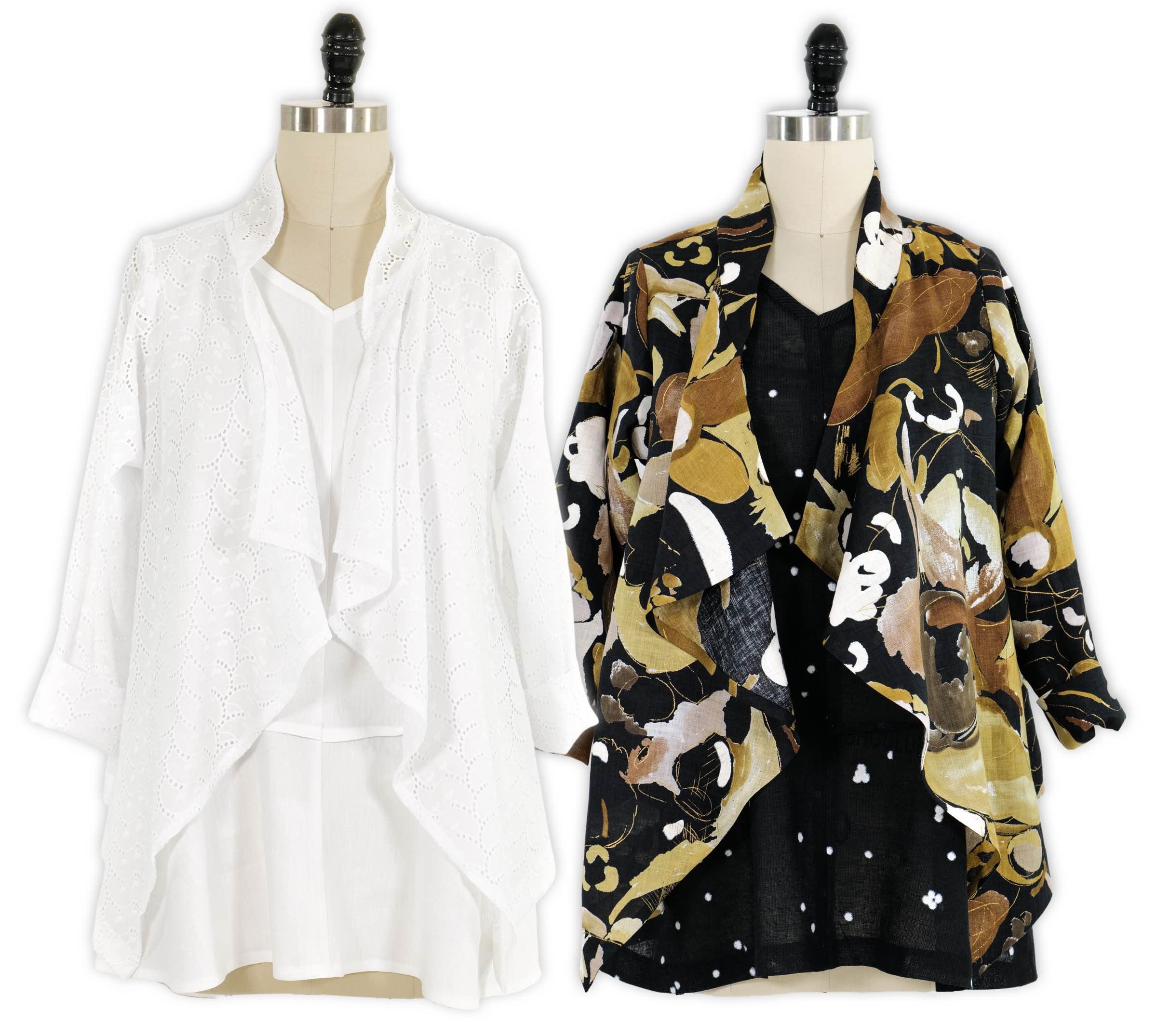The jacket is soft and drapey, designed to fall open in soft folds with a small stand collar, pockets (which you can stitch down as shown or ‘float’), with a faced hem at the cuff. The front edges are finished with a double fold clean finished edge. I used a bias facing for the hem which gives a bit of extra weight for lighter fabrics, but you could also use a simple pressed up hem. I used white eyelet for one version and a printed linen from Nani Iro for the other.


The loose fitting tunic, with sleeves or sleeveless, has a wide neck, center front and back seams with horizontal darts adding a bit of shaping.. The neck is finished with bias, and the center front and back seams are stitched after the neck edge is finished. The sleeveless armhole is finished with the same bias finish as the neck, and the hem on the sleeve version has a vent and is faced either in self or contrast fabric. I used 2 different linens for the tunics shown on the pattern envelope, and made my own version in seersucker. I love the sleeveless tunic made in a thin slippery fabric like china silk or rayon bemberg lining fabric to wear as an underlayer beneath other tops and tunics (slippery is important so the other layers do not stick, but rather float under/over the tunic), - like a modern slip!


The elastic waist soft pant has easy to sew cool oval pockets that are secured at the waist and float inside. The design is flattering and easy to wear, not too full in the up, yet loose enough to be comfortable, and tapered a touch at the hem so there is not too much fullness. I used a stretch linen for the pattern envelope version and have made others in silk and bemberg lining fabric. Knits will work for this design, but I’d use a light weight woven lining fabric for the pocket.

The Line Art Shows The Details

Sewing Tips
Tunic On the tunic, the darts are sewn to the outside. On the point of the darts, leave a long tail at the end, pull the threads to the wrong side of the fabric at the point of the dart, make a tiny knot, then run the needle along the stitching side of the dart to bury the thread. On the sleeveless version of the tunic, bind the armhole before sewing the side seam. On the tunic with sleeves, sew the sleeve in the round after the side seam is sewn/finished. I use staystitch plus to ease in fullness, then set the sleeve with the body of the garment on top using the free arm of the sewing machine. Most of us learned to set a sleeve with the sleeve on top, but this method is so much easier working with the smaller side on top so the ease just disappears. (I learned it from a fine tailor, use this method for all sleeves, knit and woven).Jacket In preparation for finishing the front edge, stitch through a single layer on jacket front edge, stitching along the seam line. This is like scoring a piece of paper to get a clean fold, the stitching acts as a fine rod and gives a clean, smooth and easy reference for pressing under. Press under along stitching line, then turn under again, making it easy to get an even clean finished edge. Collar binding should be thin and flat, with some fabrics, a self fabric is fine, for heavier/thicker fabrics, choose a light weight silky lining or cotton batiste. On our eyelet version, we used a fine light weight cotton batiste for the binding and sleeve and hem facings.
Pants The oval pocket is surprisingly easy to sew. The secret is to stitch around the oval using a small (2.0) stitch length, press flat as sewn (important as it smooths out the stitches), then cut carefully, clipping up to but not beyond the stitching in the oval. To add security to the pocket, edgestitch around the oval after pressing and turning, and press again after topstitching to smooth things out.
Marcy’s Versions I made this version as a first ‘muslin’ to test out the pattern before diving into the sample garments for the pattern envelope photos. I used a Japanese cotton seersucker which is a perfect weight for all the pieces. The first version of the jacket was asymmetrical. After wearing it for trips to LA and New York, I adapted the design, making the jacket symmetrical and paring down the collar which ended up being a bit bulky and too hot in warm weather. I prefer the final version - easier to wear, and I added pockets on both side seams.
That this is a perfect summer wardrobe, light and airy so air flows through it, comfortable out in the heat and back inside in air conditioning. The pieces will also translate well for cooler weather.


Tunic
Tunic with sleeves in cotton seersucker
Tunic with sleeves in Japanese Linen/Cotton

Pant in Silk/Linen and Washed Silk Taffeta






